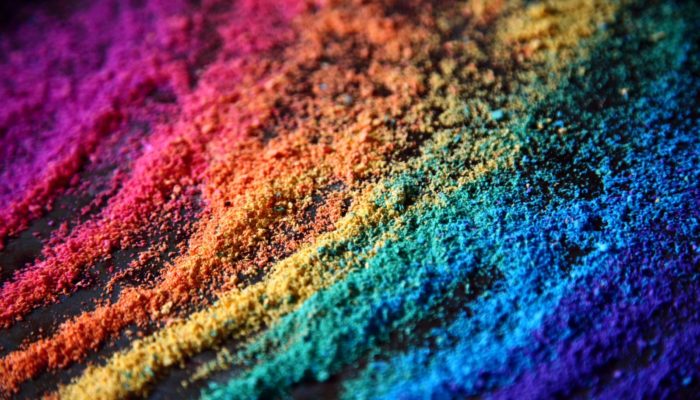
Since ancient times, colours have been fundamental for artistic expression: pigments have always been created from fruits, leaves-flowers, and minerals. During the centuries, new material discoveries and techniques increased the shades we can still see and use nowadays.
Once upon a Prehistoric time…
El Castillo Cave, in Spain, is one of the earliest known cave paintings, dated to more than 40,000 years old. Consisting of large red disks painted on the cave walls, the pigments are composed of hematite, with small amounts of quartz, illite and muscovite (d’Errico et al., 2016).
However, we have to wait Egyptian times for the first artificial pigment: the Egyptian Blue. The pigment is defined as a multi-component synthetic blue, consisting of cuprorivaite (CaCuSi4O10), and variable amounts of wollastonite, cuprite and Cu-rich glass (Jaksch et al., 1987). To obtain the pigment, the copper-rich ingredients were melted with lime and desert sand, at a temperature between 850–1050 °C (Oudbashi and Hessari, 2021).

On the left, cuprorivaite crystal from an Egyptian Blue sample (Jaksch et al., 1987). On the right, an example of Egyptian Blue from the Kanais Temple (from egyptsites.wordpress)
Cobalt blue pigment has also been used widely for vitreous material and Islamic and Chinese ceramics, from ancient times until modern days. Here, the blue comes from the cobalt pigment from the Kashan mine (Iran). In Persian text, the Kashan ore is referred to as the mine of lajvard, which means “lazuli” (Persian for blue), even if this mine is not

Ultramarine in the Sassoferrato’s painting of the Blessed Virgin Mary, c. 1654. From National Gallery – London
made of lapis lazuli stone: it was probably related to the azure colour of the cobalt deposit (Martin and Pollard, 2015). The mine is in the Karkas Mountains, and it is one of the major outcrops of the Ūrūmieh–Dokhtar magmatic arc (west-central Iran), characterized by several fault-hosted vein systems (Matin and Pollard, 2016).
The Kashan deposit is associated with an intrusive microdioritic body intruding limestones. The ore mineralization occurred in the contact zone between the sub-volcanic body and the limestone. The analysis made by Martin and Pollard (2016) defined the main cobalt-bearing minerals in the ore as cobaltite (CoAsS) and erythrite (Co3(AsO4)2·8H2O).
During the XV-XVI century, a new addition of colours occurred, given to new sources and mining discoveries (Berrie, 2015). We can see this mainly in paintings, where the pigment is now added to the oil medium. Blue was still obtained from cobalt, but also lapis lazuli stones, transported from Afghanistan, Turkey and Persia, which were ground, washed and levigated, obtaining waxes and pastes with a high cost. Indeed, the moulded ultramarine pigment was mainly used as a final layer in paintings, often commissioned by religious institutions.
Red lead (or minium) is a red-orange colour artificially created by the Romans and used till the XIX century. It was widely used in manuscripts and paintings: The Latin verb “miniare” comes from the mineral minium (Pb3O4), and, from there, the English “miniature” (Lipscher). To obtain the colour, the mineral was heated in the air at ~450°C and then grounded. It was then mixed with linseed oil to create paint. Due also to its anti-corrosive proprieties, it was applied on ironworks, such as ships and arms, to protect them from external agents. However, since ancient times, the extreme toxicity of the pigment is well known (Feller, 1986).

“Combing the Hair”, of Edgar Degas, 1895. From National Gallery -London
And nowadays?
The newest colours are mainly composed of inorganic artificial elements, as the Vantablack, acronym for Vertically Aligned Nano Tube Array Black, created in 2014 and able to absorb ~99.95% of incident light. However, we can still find mineral-based pigments, such as the titanium dioxide white (TiO2). The minerals used for the pigment are rutile and anatase, and there are two ways to prepare the colour.
First, the pure titanium oxide is converted from the minerals. If the raw material contains at least 70% of rutile, it is reduced with carbon and oxidised again with chlorine (chloride process); the formed liquid is then distilled. In the sulfate process, ilmenite (FeTiO3) is treated with sulfuric acid, then separated and converted to hydrated dioxide by heating. Produced between 1910-20, it was used by Mondrian, Pollock and Kline, and abstract artists in general, being cheap, non-toxic, and with high coverage, making it a better alternative to zinc and lead white pigments (Rogge and Arslanoglu, 2016).
These are just a few colours obtained from minerals. Among them we can find also vermillion, green earth, and malachite, just to give a few examples. The webpage Colourlex gives an incredible look at how pigments are created, dividing them by typology, age, and imaging methods. Go and check how your favourite colour is made!
References
d’Errico, Francesco, Laure Dayet Bouillot, Marcos García-Diez, Africa Pitarch Martí, Daniel Garrido Pimentel, and João Zilhão. “The technology of the earliest European cave paintings: El Castillo Cave, Spain.” Journal of Archaeological Science 70 (2016): 48-65.
Jaksch, Heiner, Wilfried Seipel, Karl-Ludwig Weiner, and Ahmed El Goresy. “Egyptian blue—Cuprorivaite a window to ancient Egyptian technology.” Naturwissenschaften 70, no. 11 (1983): 525-535.
Oudbashi, Omid, and Morteza Hessari. “A “Western” imported technology: An analytical study of the Achaemenid Egyptian blue objects.” Journal of Cultural Heritage 47 (2021): 246-256.
Matin, Moujan, and Mark Pollard. “Historical accounts of cobalt ore processing from the Kashan mine, Iran.” Iran 53, no. 1 (2015): 171-183.
Matin, M., and A. M. Pollard. “From ore to pigment: A description of the minerals and an experimental study of cobalt ore processing from the Kāshān Mine, Iran.” Archaeometry 59, no. 4 (2017): 731-746.
Berrie, Barbara H. “Mining for color: new blues, yellows, and translucent paint.” Early science and medicine 20, no. 4-6 (2015): 308-334.
Feller, Robert L. Artist’s pigments: a handbook of their history and characteristics. Vol. 1. Vol. 1. 1986.
J. Lipscher, ColourLex, http://colourlex.com/
Rogge, Corina E., and Julie Arslanoglu. “Distinguishing manufacturing practices for titanium white pigments: new Raman markers for dating commercial oil-based paints.” Studies in Conservation 61, no. sup2 (2016): 324-326.
